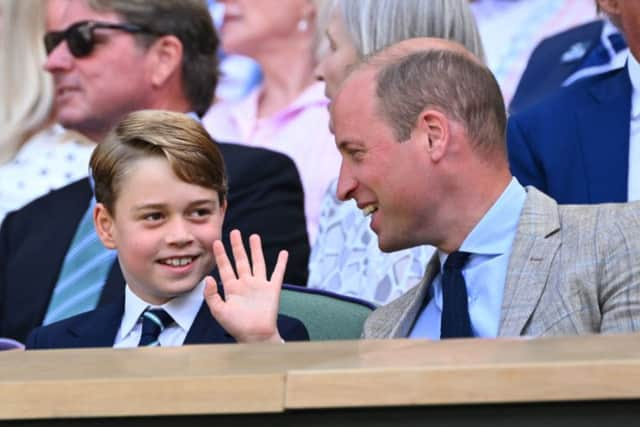Prince George given central role at King Charles’ coronation as Page of Honour
and live on Freeview channel 276
Prince George will take on a central role for the coronation of King Charles as a Page of Honour.
The King and Queen Camilla will each have four Pages of Honour supporting them on the historic day at Westminster Abbey next month.
Advertisement
Hide AdAdvertisement
Hide AdThe group of eight schoolboys are family friends or close relatives who are known well to the royal couple, including the nine-year-old future king, and will “attend their majesties during the coronation service”.
Prince George will walk behind his grandad, along with the seven other boys, as the royal procession, which includes the King and Queen, their regalia, senior clerics, and other figures, makes its way through the nave of abbey. The Pages of Honour are primarily responsible for carrying the heavy robes of some of the prominent figures during the day.


The King’s pages include his grandson George, Nicholas Barclay, 13, grandson of Sarah Troughton one of the Queen’s Companions, Lord Oliver Cholmondeley, 13, son of the Marquess of Cholmondeley, also known as film-maker David Rocksavage and a friend of the Prince of Wales, and Ralph Tollemache, 12.
The Queen’s Pages of Honour will be her three grandsons, twin boys Gus and Louis, aged 13, by her daughter Laura Lopes, and 13-year-old Freddy, by son Tom Parker Bowles, and her great-nephew, Arthur Elliot, 10.
Advertisement
Hide AdAdvertisement
Hide AdThe 12th Duke of Devonshire, when aged nine, served as a page during the late Queen’s 1953 coronation and was tasked with carrying the train of his grandmother, Mary Cavendish, Dowager Duchess of Devonshire and Mistress of the Robes.
In an interview with Sotheby’s website, he said: “My uniform, it’s still at Chatsworth, consisted of a pale yellow frock coat with blue cuffs, lace jabot at my throat, cream breeches, white silk stockings – held up by a suspender belt (garter) which I was terrified my school friends would find out about – black pumps with red heels and silver buckles and a sword on its belt.”
It is likely the eight pages chosen by King will wear something similar when they perform their duties on the big day on 6 May.
The news comes after the title Queen Camilla has been used for the first time in an official capacity, appearing on invitations for the King’s coronation. Camilla had been referred to as Queen Consort since the death of Queen Elizabeth II, but is named as Queen Camilla alongside King Charles III on the official invitations that will be sent to more than 2,000 guests.
Advertisement
Hide AdAdvertisement
Hide AdThe move marks the incredible transformation of her public image over more than five decades after she was first cast as the third person in the Prince and Princess of Wales’ marriage. She has moved from romantic involvement, to mistress and finally wife of the King, and will end with her formally being crowned Queen alongside the new King.
A royal source said: “It made sense to refer to Her Majesty as the Queen Consort in the early months of His Majesty’s reign, to distinguish from Her Majesty Queen Elizabeth II.
“‘Queen Camilla’ is the appropriate title to set against ‘King Charles’ on the invitation. The coronation is an appropriate time to start using ‘Queen Camilla’ in an official capacity. All former Queen Consorts have been known as ‘Queen’ plus their first name.”
There had been speculation about what title she would hold when Charles acceded to the throne, but the late Queen put the rumours to bed in February last year when she said it was her “sincere wish that, when that time comes, Camilla will be known as Queen Consort”.
In past centuries, the wives of monarchs have been known as Queen, and royal commentators had suggested the formal change might be made around the time of the coronation.
Comment Guidelines
National World encourages reader discussion on our stories. User feedback, insights and back-and-forth exchanges add a rich layer of context to reporting. Please review our Community Guidelines before commenting.
